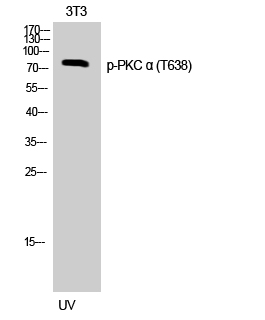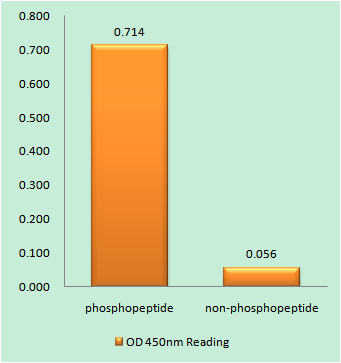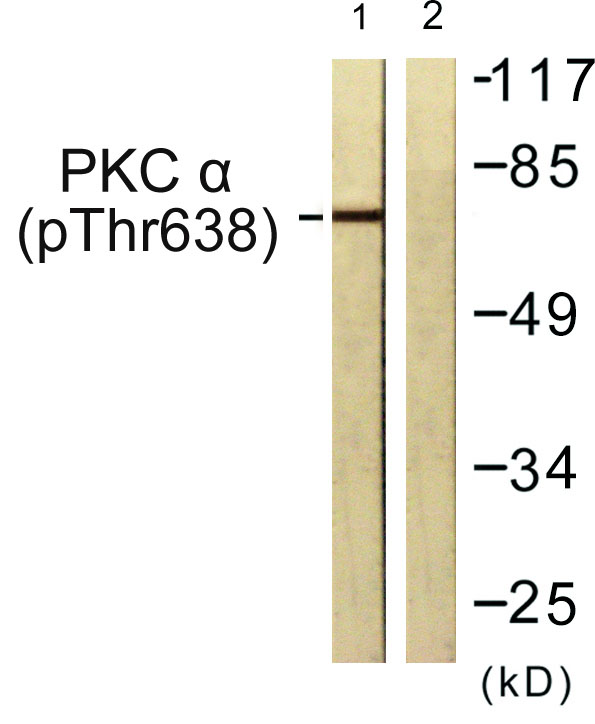PKC α (phospho Thr638) Polyclonal Antibody
- Catalog No.:YP0703
- Applications:WB;IHC;IF;ELISA
- Reactivity:Human;Mouse;Rat
- Target:
- PKC α
- Fields:
- >>EGFR tyrosine kinase inhibitor resistance;>>MAPK signaling pathway;>>ErbB signaling pathway;>>Ras signaling pathway;>>Rap1 signaling pathway;>>Calcium signaling pathway;>>HIF-1 signaling pathway;>>Phosphatidylinositol signaling system;>>Sphingolipid signaling pathway;>>Phospholipase D signaling pathway;>>mTOR signaling pathway;>>PI3K-Akt signaling pathway;>>Adrenergic signaling in cardiomyocytes;>>Vascular smooth muscle contraction;>>Wnt signaling pathway;>>Axon guidance;>>VEGF signaling pathway;>>Focal adhesion;>>Gap junction;>>Neutrophil extracellular trap formation;>>Natural killer cell mediated cytotoxicity;>>Fc epsilon RI signaling pathway;>>Fc gamma R-mediated phagocytosis;>>Leukocyte transendothelial migration;>>Circadian entrainment;>>Long-term potentiation;>>Retrograde endocannabinoid signaling;>>Glutamatergic synapse;>>Cholinergic synapse;>>Serotonergic synapse;>>GABAergic synapse;>>Dopaminergic synapse;>>Long-term depression;>>Inflammatory mediator regulation of TRP channe
- Gene Name:
- PRKCA
- Protein Name:
- Protein kinase C alpha type
- Human Gene Id:
- 5578
- Human Swiss Prot No:
- P17252
- Mouse Gene Id:
- 18750
- Mouse Swiss Prot No:
- P20444
- Rat Swiss Prot No:
- P05696
- Immunogen:
- The antiserum was produced against synthesized peptide derived from human PKC alpha around the phosphorylation site of Thr638. AA range:606-655
- Specificity:
- Phospho-PKC α (T638) Polyclonal Antibody detects endogenous levels of PKC α protein only when phosphorylated at T638.
- Formulation:
- Liquid in PBS containing 50% glycerol, 0.5% BSA and 0.02% sodium azide.
- Source:
- Polyclonal, Rabbit,IgG
- Dilution:
- WB 1:500 - 1:2000. IHC 1:100 - 1:300. ELISA: 1:20000.. IF 1:50-200
- Purification:
- The antibody was affinity-purified from rabbit antiserum by affinity-chromatography using epitope-specific immunogen.
- Concentration:
- 1 mg/ml
- Storage Stability:
- -15°C to -25°C/1 year(Do not lower than -25°C)
- Other Name:
- PRKCA;PKCA;PRKACA;Protein kinase C alpha type;PKC-A;PKC-alpha
- Observed Band(KD):
- 76kD
- Background:
- Protein kinase C (PKC) is a family of serine- and threonine-specific protein kinases that can be activated by calcium and the second messenger diacylglycerol. PKC family members phosphorylate a wide variety of protein targets and are known to be involved in diverse cellular signaling pathways. PKC family members also serve as major receptors for phorbol esters, a class of tumor promoters. Each member of the PKC family has a specific expression profile and is believed to play a distinct role in cells. The protein encoded by this gene is one of the PKC family members. This kinase has been reported to play roles in many different cellular processes, such as cell adhesion, cell transformation, cell cycle checkpoint, and cell volume control. Knockout studies in mice suggest that this kinase may be a fundamental regulator of cardiac contractility and Ca(2+) handling in myocytes. [provided by RefSeq, Jul 2
- Function:
- catalytic activity:ATP + a protein = ADP + a phosphoprotein.,cofactor:Binds 3 calcium ions per subunit. The ions are bound to the C2 domain.,function:PKC is activated by diacylglycerol which in turn phosphorylates a range of cellular proteins. PKC also serves as the receptor for phorbol esters, a class of tumor promoters.,function:This is a calcium-activated, phospholipid-dependent, serine- and threonine-specific enzyme. May play a role in cell motility by phosphorylating CSPG4.,similarity:Belongs to the protein kinase superfamily.,similarity:Belongs to the protein kinase superfamily. AGC Ser/Thr protein kinase family. PKC subfamily.,similarity:Contains 1 AGC-kinase C-terminal domain.,similarity:Contains 1 C2 domain.,similarity:Contains 1 protein kinase domain.,similarity:Contains 2 phorbol-ester/DAG-type zinc fingers.,subunit:Interacts with ADAP1/CENTA1, CSPG4 and PRKCABP. Binds to SDPR
- Subcellular Location:
- Cytoplasm . Cell membrane ; Peripheral membrane protein . Mitochondrion membrane ; Peripheral membrane protein . Nucleus .
- Expression:
- Blood,Brain,Epithelium,Lung,Platelet,
- June 19-2018
- WESTERN IMMUNOBLOTTING PROTOCOL
- June 19-2018
- IMMUNOHISTOCHEMISTRY-PARAFFIN PROTOCOL
- June 19-2018
- IMMUNOFLUORESCENCE PROTOCOL
- September 08-2020
- FLOW-CYTOMEYRT-PROTOCOL
- May 20-2022
- Cell-Based ELISA│解您多样本WB检测之困扰
- July 13-2018
- CELL-BASED-ELISA-PROTOCOL-FOR-ACETYL-PROTEIN
- July 13-2018
- CELL-BASED-ELISA-PROTOCOL-FOR-PHOSPHO-PROTEIN
- July 13-2018
- Antibody-FAQs
- Products Images

- Western Blot analysis of 3T3 cells using Phospho-PKC α (T638) Polyclonal Antibody

- Enzyme-Linked Immunosorbent Assay (Phospho-ELISA) for Immunogen Phosphopeptide (Phospho-left) and Non-Phosphopeptide (Phospho-right), using PKC alpha (Phospho-Thr638) Antibody

- Immunohistochemistry analysis of paraffin-embedded human breast carcinoma, using PKC alpha (Phospho-Thr638) Antibody. The picture on the right is blocked with the phospho peptide.

- Western blot analysis of lysates from NIH/3T3 cells treated with UV 15', using PKC alpha (Phospho-Thr638) Antibody. The lane on the right is blocked with the phospho peptide.


